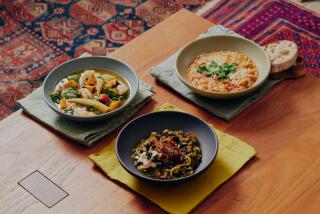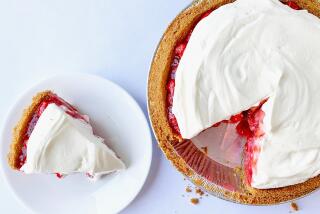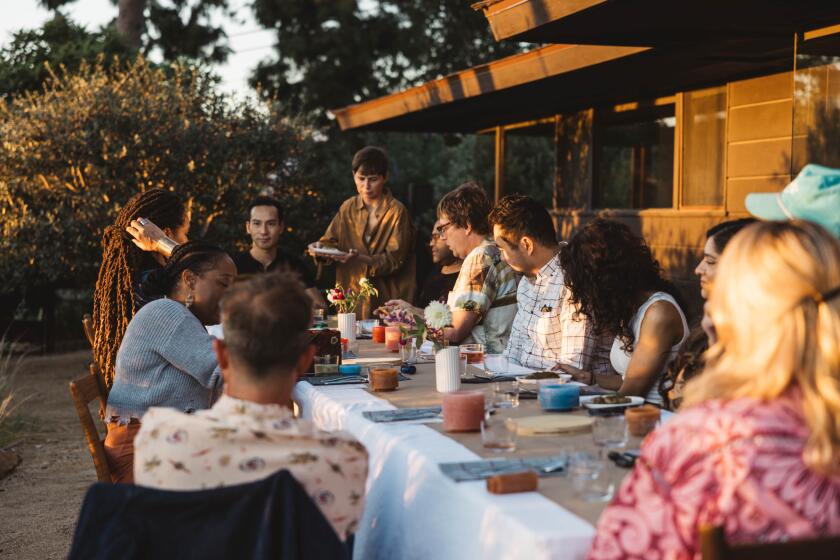An American meal
When Thanksgiving spread around the country in the mid-19th century, it was in the hope that holiday good feelings would heal the rift between North and South. So, the Thanksgiving menu had a certain amount of can’t-we-all-get-together culinary nationalism to it.
The main course? Turkey, of course, an indigenous American bird. It was well known that Native Americans and the early colonists used cranberries to flavor meat, so you clearly had to serve cranberry sauce with your bird. Americans were renowned pie-eaters in the 19th century, making pie the obvious dessert, and the supreme holiday pie was filled with pumpkin -- another native American ingredient.
As a result, roast turkey, cranberry sauce and pumpkin pie became emphatically tied to the holiday. Until the cranberry juice craze and the discovery that turkey breast is low in fat, quite a few Americans never ate turkey or anything cranberry between one Thanksgiving and the next, and that’s probably still true of pumpkin pie.
Outside the turkey-cranberry-pumpkin pie trinity, though, American Thanksgiving tables have been as varied as the country itself. Each region, even each family, has its own list of traditional dishes without which the holiday menu is unthinkable.
It’s surprising how tenacious these traditions can be. My grandfather insisted on having Boston brown bread, though his great-grandparents had left Massachusetts for New York in the 1780s. His family must not be the only one to feel that way -- brown bread does tend to show up on grocery shelves around the holiday season.
Some of these family dishes would shock anyone from a different tradition. Who would think of serving stewed sauerkraut with the turkey? Quite a few people from German families, such as in the Midwest. Coconut cream pie alongside (or even instead of) pumpkin? That’s purely Southwestern. There are a few isolated areas, such as parts of West Texas, where turkey is even optional -- chicken can substitute for it, possibly because turkeys were once unavailable and chicken simply became the tradition.
--
To each his own
Well, Thanksgiving is all about tradition. Families with a strong immigrant heritage may garnish their roast turkey with spaghetti, enchiladas or stir-fried vegetables instead of sweet potatoes and succotash. Lebanese American cooks tend to use their ancestral roast chicken stuffing -- fried lamb, onions and pine nuts -- and may even boil the turkey before roasting it. The Portuguese of New England often start the meal with their traditional kale soup, caldo verde.
The Thanksgiving menu was spread around the country in the 1850s partly by homesick New Englanders bringing their party with them wherever they moved and partly through the efforts of Sarah Joseph Hale, editor of the most influential publication in the country, Godey’s Lady’s Book. She started using her position to promote the idea of Thanksgiving in the 1840s, and by 1860, the custom had spread to nearly all the states. During the Civil War, she persuaded President Lincoln to declare a national Thanksgiving Day, and the date he chose for it is basically the one we use today.
Hale had fond memories of her family’s bountiful Thanksgivings in Maine, and the holiday menu she publicized is still the norm in New England. One thing that may strike people from other parts of the country is the prominence of plain boiled vegetables: boiled turnips, boiled cabbage, boiled onions.
The South originally accepted Thanksgiving with some reluctance. Until the 19th century, New Englanders had refused to celebrate Christmas on the grounds that there was no scriptural warrant for the Dec. 25 date for the birth of Christ, so Southerners suspected Thanksgiving of being some kind of bogus Yankee imitation of Christmas.
Partly for this reason, and partly because the South has the most vigorous food traditions in the country, Southern Thanksgiving menus tend to be rather distinctive. For instance, it’s common in the South to serve red meat alongside the turkey -- country ham in Maryland, ham or roast beef in Memphis, Tenn.
Corn bread stuffing is also very Southern, though bread or chestnut stuffings from the English tradition are also common in the South. Sweet potatoes topped with marshmallows are as Midwestern as Southern, but if there are pecans involved, you can be sure you’re in Dixie.
Southerners cheerfully throw in dishes with not the remotest New England connection, such as macaroni and cheese, potato salad or ambrosia. Particularly in Texas, pie doesn’t have to be limited to the traditional pumpkin-apple-mincemeat repertoire. Out there, dessert can be lemon chiffon pie or coconut cream pie . . . or even chocolate cake.
In the Midwest, the squash that would probably be boiled and maybe mashed farther east is likely to be stuffed and baked. This is the part of the country where you find the most German and Scandinavian influences. The turkey may come with stewed sauerkraut, dumplings or noodles, and European cakes, custards or strudels may show up alongside the pies.
--
Oysters were king
In the 19th century, Americans were crazy for oysters, and there was a repertoire of dishes such as oyster stew, pan-fried oysters and scalloped oysters that was known throughout the country. Oysters were particularly associated with the holiday season. Even deep in the Midwest, people would order a barrel of oysters delivered by rail and serve oyster dishes at Thanksgiving (and clear on through Christmas).
In most places, oysters have nearly disappeared from the Thanksgiving table except for the occasional turkey stuffing, but oyster stew, scalloped oysters and the rest are still popular in oyster-producing areas such as the Pacific Northwest (and in Amish and Mennonite communities as far inland as Indiana, because the Amish and Mennonites don’t change their traditions at the drop of a hat).
California, and particularly Los Angeles, has been inundated with newcomers for over a century, and we don’t have the deep-rooted traditions of New England or the South. We do have a few, though. Green salad, for instance; not many of us would serve Jell-O salad alone without a healthful lettuce and tomato salad.
Some families still serve the old-time L.A. relish tray: carrot and celery spears, olives and pickles (such as pickled peppers). This was our local version of the 19th century tradition of serving rare and expensive appetizers, except that around here we featured olives and celery out of local patriotism because we grew our own.
It’s possible to generalize about regional and ethnic versions of the Thanksgiving dinner, but the fact is that Thanksgiving is a family holiday, and its traditions are always family traditions. Even in areas of cultural homogeneity, people may be a little surprised by what their neighbors serve.
These days, all those regional and ethnic lines are blurring as people move around the country and marry outside their cultures. So, more and more families are experiencing holiday shock: “You want to put sausage in the turkey stuffing?” “You put oysters -- seriously, oysters? -- in the stuffing?” It always gets sorted out, and it’s fascinating to see which traditions are more persistent in any given family.
What will Thanksgiving dinner be like in 2109? My guess is it won’t be a complete free-for-all of eclecticism, because families need traditions, and so do countries. I’m not so sure about pumpkin pie, but I’m putting my money on turkey and cranberry.
Additional reporting by Christianne Winthrop, Michael Mao and Raeny Ji.
--
--
Caldo verde
Total time: About 50 minutes
Servings: 6 to 8
Note: Adapted from “The New England Cookbook” by Brooke Dojny.
2 tablespoons olive oil
1/2 pound sausage, preferably Spanish chorizo, linguica or kielbasa, thinly sliced
1 large onion, chopped
4 cups chicken broth
1 1/2 pounds boiling potatoes, peeled and thinly sliced
1 pound kale, thick stems removed and sliced crosswise into 1/4-inch strips
2 cups water, more as needed
Salt and pepper
Best quality olive oil, for garnish (preferably Spanish)
1. In a large saucepan or soup pot, heat the oil over medium heat until hot. Stir in the sausage and onion and cook, stirring occasionally, until the sausage browns and the onion softens, about 10 minutes.
2. Stir in the broth, potatoes, kale and water. Bring to a boil over high heat, then reduce to a simmer and cook, partially covered, until the potatoes are very soft (almost falling apart) and the kale is tender, about 30 minutes.
3. Use a large fork or whisk to break up some of the potatoes against the side of the pot to thicken the soup. Adjust the liquid as desired, adding more broth or water. Season to taste with salt and pepper. Garnish each serving with a drizzle of olive oil, if desired.
Each of 8 servings: 253 calories; 11 grams protein; 20 grams carbohydrates; 3 grams fiber; 15 grams fat; 5 grams saturated fat; 25 mg. cholesterol; 2 grams sugar; 559 mg. sodium.
--
Southern stuffing
Total time: About 1 1/2 hours, plus cooling time for the corn bread
Servings: 6 to 8
Note: Adapted from “Stuffed Griffin” by the Utility Club of Griffin, Ga. The corn bread is adapted from Gourmet magazine.
Toasted cubed corn bread
1 cup flour
1 1/2 cups yellow cornmeal
1 tablespoon baking powder
1 teaspoon salt
1 cup milk
1 egg
3 tablespoons butter, melted and cooled
1. Heat the oven to 425 degrees.
2. In a large bowl, whisk together the flour, cornmeal, baking powder and salt. Separately, in a medium bowl, whisk together the milk, egg and butter.
3. Whisk the milk mixture into the flour mixture and pour into a greased 8-inch square pan. Bake until pale golden and a toothpick inserted in the center comes out clean, about 20 to 25 minutes.
4. Cool 5 minutes, invert on a rack and cool completely.
5. Turn the oven down to 350 degrees. When the bread is cool, cut it into rough 1-inch cubes and place them in a baking pan. Bake, stirring occasionally, until the bread is dry and deep golden, about 20 minutes. (Recipe can be prepared to this point 1 day in advance and stored at room temperature.)
Assembly and baking
2 teaspoons oil
2 cups chopped celery
1 cup chopped onion
Toasted cubed corn bread
4 cups cracker meal
1 tablespoon seasoning salt
2 teaspoons celery salt
6 eggs, beaten
1 cup milk
3 cups turkey or chicken broth
1 teaspoon black pepper
1. Heat the oven to 350 degrees.
2. Heat the oil in a large skillet over medium high heat and saute the celery and onion until barely tender, about 5 minutes, stirring occasionally. Remove from heat and cool slightly.
3. Combine the celery, onion, corn bread, cracker meal, seasoning salt, celery salt, eggs, milk, broth and pepper in a large bowl. Mix well and place in an oiled 9-by-13-inch baking dish.
4. Bake until the top is golden brown, about 45 minutes.
Each of 8 servings: 556 calories; 18 grams protein; 88 grams carbohydrates; 4 grams fiber; 14 grams fat; 6 grams saturated fat; 203 mg. cholesterol; 5 grams sugar; 1,566 mg. sodium.
--
Stuffed acorn squash
Note: This recipe is adapted from “Cooking From Quilt Country” by Marcia Adams. She says some families enrich the stuffing with some chopped ham.
Total time: About 2 hours
Servings: 4 to 6
2 acorn squash
1 tablespoon oil
1 cup chopped onion
2 tablespoons minced parsley
1 slice dense textured brown bread
2 tablespoons butter, melted
1/4 cup ( 1/2 stick) butter, softened
1/4 cup sour cream
1 egg
Salt and pepper
1. Heat the oven to 350 degrees. Cut the squashes in half and remove the seeds. Set them cut side down on a baking dish covered with aluminum foil, add water to half fill and bake until the squashes are soft, about 1 hour.
2. While the squashes are baking, heat the oil in a small skillet and saute the onion over medium heat until translucent, about 8 to 10 minutes. Add the parsley, stir and remove from the heat.
3. Process the bread to fine crumbs in a blender (you should have about 1/2 cup), add the 2 tablespoons melted butter, process together and set aside.
4. Process the onion and parsley until well chopped. Scrape out the squash flesh, leaving about three-fourths inch next to the shell. Add the squash flesh to the onion and parsley along with the 1/4 cup butter, the sour cream and the egg and process until smooth. Season to taste with salt and pepper.
5. Fill the acorn squash shells with this puree and top with the buttered bread crumbs. Set cut side up on a buttered baking dish and bake until the filling is somewhat set and the crumbs are brown, 25 to 30 minutes.
Each of 6 servings: 279 calories; 4 grams protein; 22 grams carbohydrates; 3 grams fiber; 22 grams fat; 11 grams saturated fat; 82 mg. cholesterol; 5 grams sugar; 92 mg. sodium.
--
Scalloped oysters
Total time: 40 minutes
Servings: 6 to 8
Note: This recipe is adapted from “Choice Recipes” by members of the Fruit and Flower Mission in Seattle.
1 pint cracker crumbs, divided
1 pint oysters, liquor reserved, divided
Salt and pepper
1 stick butter, melted plus more for buttering dish
1 egg
2/3 cup whole milk
1. Heat the oven to 350 degrees.
2. Butter a 9-inch by 5-inch baking dish and cover the base with a thin layer of crumbs, about 1/3 cup. Drizzle 3 tablespoons oyster liquor over the crumbs and cover with a layer of oysters. Season the oysters with a pinch each of salt and pepper.
3. Cover with another 1/3 cup cracker crumbs and drizzle over half of the melted butter. Add a second layer of oysters, then top with the remaining crumbs.
4. In a medium bowl, whisk together the egg and milk, then pour the mixture over the crumbs. Drizzle over the remaining butter.
5. Bake until the oysters are firm and the edges are golden-brown, about 30 minutes. Remove from heat and cool slightly before serving.
Each of 8 servings: 276 calories; 9 grams protein; 27 grams carbohydrates; 1 gram fiber; 15 grams fat; 8 grams saturated fat; 93 mg. cholesterol; 1 gram sugar; 96 mg. sodium.
--
Lemon chiffon pie
Total time: 45 minutes plus chilling time
Servings: 8
Note: Adapted from “American Regional Cooking” by Sheila Hibben.
1 ( 1/4 ounce) packet (about 1 1/2 teaspoons) unflavored gelatin
3 tablespoons water
4 eggs, separated and divided
1 cup sugar, divided
1/4 teaspoon salt
1/2 cup lemon juice
1 1/2 teaspoons grated lemon zest
1/2 cup heavy cream, whipped
Baked pie crust
1. In a small bowl, drizzle the gelatin over the cold water to soak.
2. Meanwhile, in a medium metal bowl, whisk together the egg yolks with 1/2 cup sugar, the salt, lemon juice and lemon zest. Place the bowl over a larger pot of simmering water and cook, stirring constantly, until the mixture is thickened to a custard-like consistency, about 8 minutes. Add the soaked gelatin and stir until dissolved. Remove from heat and place the mixture over an ice bath, stirring just until cooled to room temperature. Remove from the ice bath and set aside.
3. In the bowl of a stand mixer, or in a large bowl using an electric mixer, beat the egg whites until foamy. With the mixer running, drizzle the remaining 1/2 cup of sugar over the whites and continue beating until the whites form stiff peaks.
4. In a separate bowl, beat the heavy cream until stiff peaks form.
5. Mix approximately one-fourth of the beaten egg whites into the cooled lemon mixture to lighten it. Fold in the remaining egg whites, followed by the stiffly whipped cream, taking care not to deflate the filling as it is combined.
6. Turn the filling into the baked pie crust and refrigerate at least 4 hours to allow the filling to set up.
Each serving: 291 calories; 6 grams protein; 38 grams carbohydrates; 1 gram fiber; 14 grams fat; 6 grams saturated fat; 126 mg. cholesterol; 27 grams sugar; 204 mg. sodium.
More to Read
Eat your way across L.A.
Get our weekly Tasting Notes newsletter for reviews, news and more.
You may occasionally receive promotional content from the Los Angeles Times.








